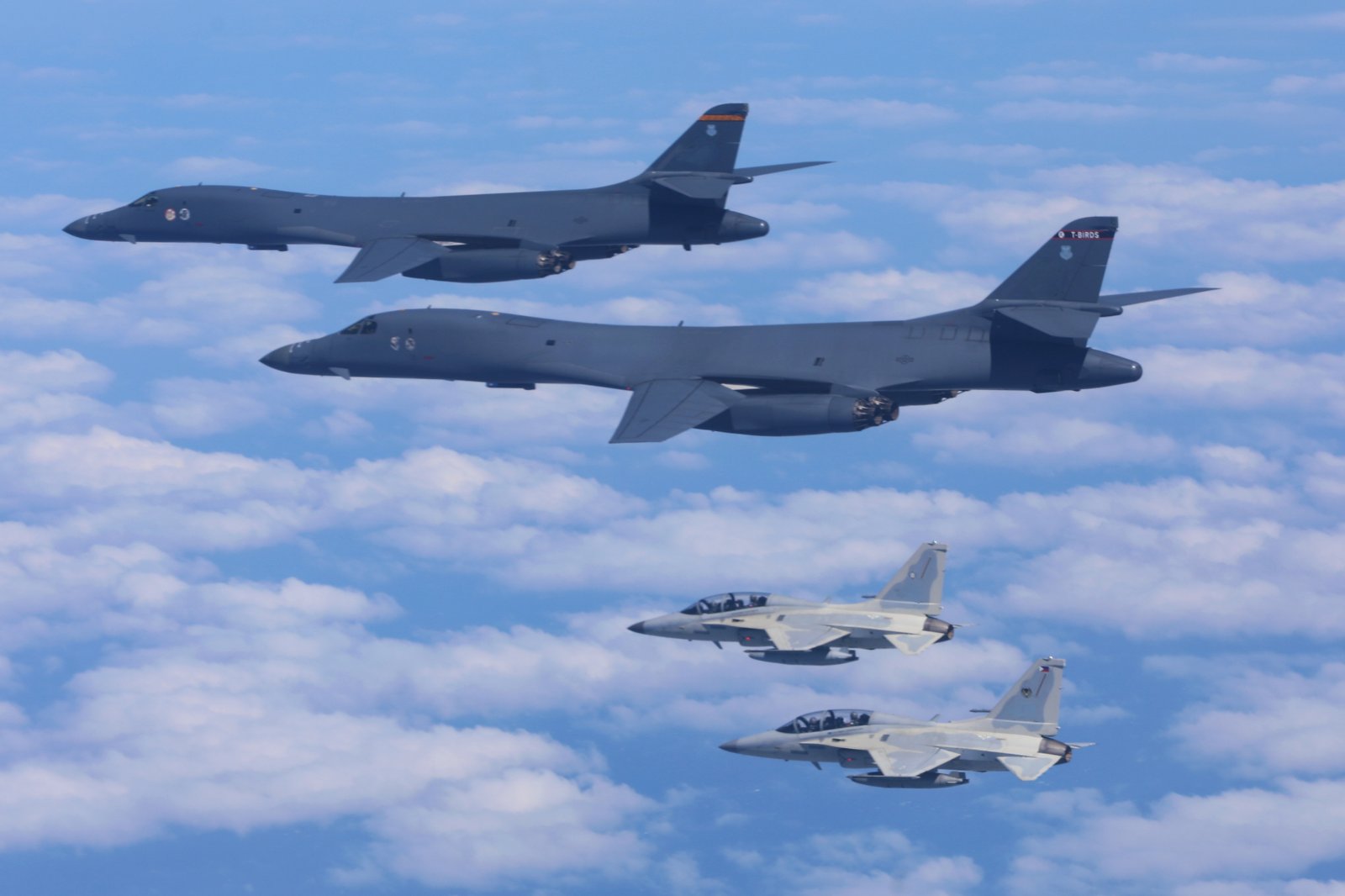In a display of allied strength and tactical synergy, US B-1 “Lancer” bombers, a staple of American air power for over five decades, teamed up with the FA-50PH fighter jets of the Philippine Air Force (PAF) in a key drill over the West Philippine Sea on February 4.
PAF spokesperson Col. Ma. Consuelo Castillo confirmed the successful execution of a bilateral air patrol and photo exercise during a press briefing at Camp Aguinaldo.
The exercise included maneuvering the aircraft within the Philippines’ exclusive economic zone (EEZ). According to Castillo, the exercise was aimed at strengthening interoperability between the two air forces while enhancing air domain awareness and agile combat employment capabilities.
The aircraft rendezvoused off the west coast of the Philippines, flying within the Intensive Military Training Area (IMTA), which includes the contested Bajo de Masinloc (Scarborough Shoal).
The joint patrol was conducted under the framework of the Mutual Defense Board-Security Engagement Board (MDB-SEB), which oversees military cooperation between the Philippines and the United States.

While regional tensions have been rising due to increased Chinese activities in the South China Sea, Castillo clarified that the exercise was pre-planned and not linked to any specific recent developments.
No Chinese aircraft or radio challenges were detected during the operation.
The US B-1B bombers involved in the exercise are currently deployed to Andersen Air Force Base, Guam, as part of Bomber Task Force 25-1.
These aircraft belong to the 34th Expeditionary Bomb Squadron, Ellsworth Air Force Base, and have been participating in various training missions across the Indo-Pacific region.
The West Philippine Sea remains a flashpoint in the broader South China Sea dispute. Although Bajo de Masinloc lies within the Philippines’ EEZ, China has maintained control over the shoal since a 2012 standoff between the two nations. The Philippines continues to assert its claims through diplomatic channels and military presence in the region.
In a separate development, the Philippine Navy is set to participate in the 5th Multilateral Naval Exercise Komodo (MNEK) in Bali, Indonesia, from February 15 to 22.
Navy spokesperson Captain John Percie Alcos confirmed that the BRP Ramon Alcaraz (PS-16), an offshore patrol vessel, will be deployed for the exercise. The Philippine Navy will take part in both maritime operations and non-warfare-related activities alongside regional partners.
B-1 Lancer & FA-50PH Fighter Jet
The B-1, which has been in service since the 1980s, is known for its long-range strike capabilities, high-speed precision bombing, and versatility.
Its deployment in the region is seen as a powerful message to Beijing and signals the US commitment to its allies and freedom of navigation in the disputed waters of the South China Sea.
On the other hand, the FA-50PH, a modern light combat aircraft, represents the PAF’s first line of defense in maintaining air superiority over the contested areas.
Its high agility and multirole capabilities make it an ideal partner for the B-1 during complex air drills, where both nations aim to demonstrate a unified front against any aggressive posturing from China.
The Philippines currently operates around 12 FA-50 fighter jets, which were first acquired in March 2014 through a contract with Korea Aerospace Industries (KAI). The initial delivery began in November 2015, with the entire fleet arriving by May 2017.
Now, the Philippines is expected to secure a deal for an additional 12 FA-50 Block 20 light fighters, effectively doubling its FA-50 fleet and significantly enhancing its air defense capabilities.
This potential fleet expansion comes amid growing tensions with China, which has persistently challenged Philippine forces in the South China Sea near contested features such as the Thomas and Sabina Shoals.
The new aircraft will strengthen the Philippines’ ability to defend its territorial claims in the face of ongoing provocations.
The FA-50 is a lightweight fighter, and in the hands of a well-trained pilot, it can pose a challenge to China’s older combat aircraft, as well as its maritime patrol and airborne early warning platforms.
Overall, the joint exercise is a clear demonstration of a formidable combination of old and new. As the B-1 bombers provided heavy firepower and strategic reach, the FA-50PH jets showcased their role as an agile and nimble force designed for rapid response, and close combat engagements.
Moreover, the drills served as a reminder of the growing military cooperation between the Philippines and the US to counteract Beijing’s growing military presence in the region.
- Contact the author at ashishmichel(at)gmail.com
- Follow EurAsian Times on Google News




